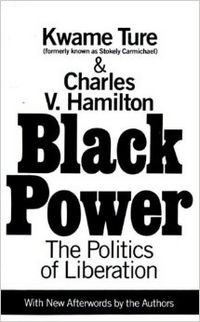Black Power: The Politics of Liberation facts for kids

1992 Edition Cover
|
|
| Author | Stokely Carmichael and Charles V. Hamilton |
|---|---|
| Country | United States |
| Language | English |
| Genre | Political Philosophy, Africana Studies, Political Science |
|
Publication date
|
October 23, 1967 |
| Pages | 256 |
| ISBN | 0679743138 |
Black Power: The Politics of Liberation is an important book from 1967. It was written by Stokely Carmichael (also known as Kwame Ture) and Charles V. Hamilton, who was a political scientist. This book explains what "Black Power" means. It also looks at the reasons for racism in the United States. The authors suggest ways to improve how black communities can take part in politics. This book became a key text during the Civil Rights Movement and the Black Power movement.
Contents
Understanding Black Power and Its Challenges
This book mainly talks about the difficulties black communities faced when trying to get involved in politics. Since the Civil War, black people had experienced harsh and unfair treatment. They also faced segregation, which meant they were kept separate from white people. This made it very hard for them to vote or join political activities.
Why Political Participation Was Hard
The authors, Carmichael and Hamilton, explain why these problems existed. They point to white supremacy, which is the belief that white people are superior. They also mention colonialism, which is when one country takes control of another. These ideas led to a system where black people were often prevented from voting or having a say in government. This unfair system made it difficult for black communities to gain political power.
Groups Working for Change
Because of these issues, several groups and organizations were formed. For example, the Student Nonviolent Coordinating Committee (SNCC) worked to build strong groups within black communities in the Southern United States. They offered a new choice to the main Democratic Party in Mississippi. This new group, called the Mississippi Freedom Democratic Party, wanted to adopt the national party's goals.
SNCC helped run local campaigns and supported black candidates for office. They saw success within their own communities. However, these groups often had limited power. Their efforts to help black communities in politics were not always fully successful. This led Carmichael and Hamilton to think about Black Power in a bigger way. They saw it as a tool to fight all forms of unfair treatment, not just political representation.
True Partnerships for Change
Carmichael and Hamilton also wrote about how attempts by black communities to be active in politics were often stopped. They felt this happened because some groups offered only weak support. The authors criticized labor movements, liberals, and the middle class. They believed these groups were too comfortable with the unfair system of racism.
The book Black Power challenges groups to truly support anti-racism and the needs of the black community. Carmichael and Hamilton state that real partnerships can only happen if everyone involved is ready to challenge white supremacy. They also believe it's important to challenge other unfair rules and systems.
Black Power: More Than Just Politics
Carmichael and Hamilton explain that Black Power meant more than just improving the living conditions of black Americans. It also meant changing how people thought about race relations throughout history. This applied to both people inside and outside the black community.
The authors believed that Black Power involved not only taking apart white supremacy. It also meant building strong friendships and unity within the black community. In this way, Black Power rejected traditional, conforming politics. Instead, it aimed for a degree of independence and self-rule for the black community.
In 1975, the Ohio prison library included Black Power in its list of books.

